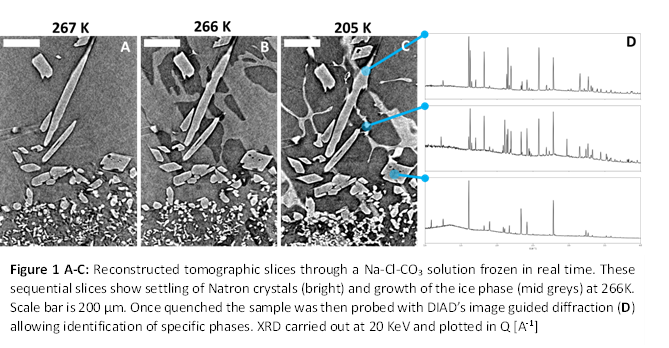Using synchrotron X-ray diffraction and X-ray tomography to study ocean world cryogeochemistry in 4D.
- Diamond Light Source, Didcot, United Kingdom (liam.perera@diamond.ac.uk)
The plumes of Enceladus contain a non-ice component that originates from aqueous processes occurring within the interior 1,2. The ocean of Enceladus is thought to be connected to the surface across a range of time scales. These processes range from the rapid eruption of cryovolcanic plumes to slow crustal convection on geological timescales3,4. In every case, the system will have a temperature and geochemical evolution as it freezes, with the history of evolution recorded in the sequence of mineral precipitation. Analogously to igneous and metamorphic petrology, we can explore the mineralogy and its context to reconstruct the history of that sample. Most importantly, for astrobiological investigations, the formation and cryo-petrological study of inorganic salts can be used to identify sites of recent exposure on the surface.
Synchrotron X-ray techniques allow fast, high-resolution probing of these systems with X-ray light. By exploring large, multi-component samples with multiple techniques, with variable temperature over time we can reveal many emergent processes that may not be predictable with simple phase diagrams.
We use a combination of synchrotron powder X-ray diffraction (PXRD) and X-ray microtomography (µCT) across multiple beamlines at Diamond Light Source (I11, I12 and DIAD). Using a multi-modal approach, we present an in-situ study of the low-temperature phase behaviour of Na-Cl-HCO3 fluids. We employ K11-DIAD (Dual Imaging and Diffraction) to carry out ‘image-guided diffraction’ on an Enceladus-type sample frozen in real-time. DIAD’s unique capabilities allow us not only to study microstructure down to 1 µm but also to carry out spatially resolved XRD and identify solid phases present.
We present, for the first time, the use of dual imaging and diffraction of a Na-Cl-CO₃ solution frozen in real time in 3 dimensions [Figure 1]. DIAD’s imaged guided diffraction provides spatially-resolved XRD, allowing us to probe different regions of our sample and identify the formation of Na2CO₃ hydrates. We show the influence of carbonate chemistry on the sequence of cryogenic precipitation and the development of complex microstructures. These results provide insights into crustal transport processes and will help with interpreting observational data from upcoming Galilean missions.
[1] Postberg F, Schmidt J, Hillier J, Kempf S, Srama R. A salt-water reservoir as the source of a compositionally stratified plume on Enceladus. Nature 2011; 474: 620–622.
[2] Sekine Y, Shibuya T, Postberg F, Hsu H-W, Suzuki K, Masaki Y et al. High-temperature water–rock interactions and hydrothermal environments in the chondrite-like core of Enceladus. Nat Commun 2015; 6: 8604.
[3] Schoenfeld AM, Hawkins EK, Soderlund KM, Vance SD, Leonard E, Yin A. Particle entrainment and rotating convection in Enceladus’ ocean. Commun Earth Environ 2023; 4: 28.
[4] Vance SD, Journaux B, Hesse M, Steinbrügge G. The Salty Secrets of Icy Ocean Worlds. JGR Planets 2021; 126: e2020JE006736
How to cite: Perera, L., Day, S., Thompson, S., Leonardi, A., and Ahmed, S.: Using synchrotron X-ray diffraction and X-ray tomography to study ocean world cryogeochemistry in 4D., Europlanet Science Congress 2024, Berlin, Germany, 8–13 Sep 2024, EPSC2024-1090, https://doi.org/10.5194/epsc2024-1090, 2024.